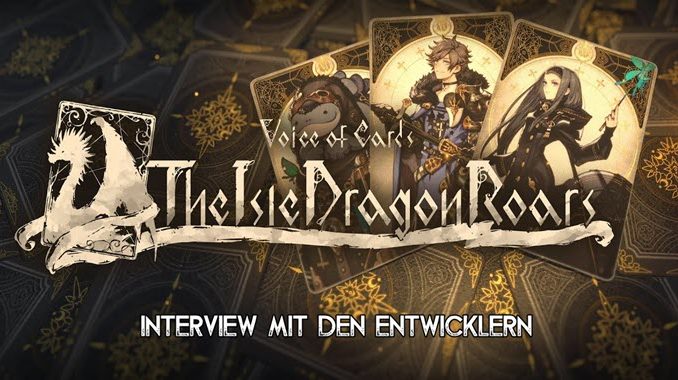
Wir durften den Machern von Voice of Cards ein paar Fragen stellen. Hier findet ihr die Antworten 🙂
Interviewpartner:
- Yoko Taro, Creative Director
- Yosuke Saito, Executive Producer
- Kimihiko Fujisaka, Character Designer
- Maasa Mimura, Director
Voice of Cards: The Isle Dragon Roars ist ein RPG, das in einer Welt der Schwerter und Zauberei spielt und dabei wird es vollständig mittels Karten erzählt.
Mit der Geschichte folgen wir einem selbsternannten Helden, der sich auf den Weg macht, einen vor Kurzem erwachten Drachen zu töten. Der Stil des Spiels wird dabei im Stil eines Tabletop-RPGs präsentiert und dabei erweckt der Spielleiter diese Welt zum Leben.
Hier findet ihr unser Review: Voice of Cards: The Island of Dragon Roar
Vorab vielen Dank an die Beteiligten, dass wir die Gelegenheit bekommen, Ihnen einige Fragen stellen zu dürfen. Das Spiel hat uns sehr viel Spaß gemacht – die Struktur, das Gameplay und die Story erzeugen eine fantastische Atmosphäre.
Yoko Taro: Es freut mich, wenn Leute meine Spiele „exzellent“ oder „spaßig“ finden, aber ihr habt das Beste am Spiel nicht bedacht: die Musik!
Der Komponist Keiichi Okabe hat sein Bestes gegeben und verdient so viel Lob, auch wenn er ein wenig abhebt, wenn er davon zu viel bekommt.
Crystal Universe: Es scheint ein aktueller Trend in der Spielebranche zu sein, Spielkarten als separates Minispiel-Element in größeren Titeln zu verwenden. VoC ist wohl das erste Spiel, das auf diesem Element basiert und eine ganze Story und Welt aufbaut. Wie sind Sie auf diese Idee gekommen?
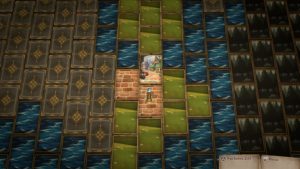
Yoko Taro: Alle Spiele bestehen aus Symbolen und Figuren. Dinge wie spielbare Charaktere, Bosse, HP, MP, etc. sind nichts außer eben diese. Also habe ich mich dazu entschieden, all diese Elemente auf Karten zu bringen, die schlussendlich die symbolische Darstellung dieses Spiels sind.
Das ist eine Lüge! Der wahre Grund, warum ich das gemacht habe: Es kostet Geld, 3D-Modelle zu erstellen. Also bin ich zur billigeren Variante ausgewichen…
Crystal Universe: Sie haben verschiedene Würfel und einige Edelsteine als Elemente in den Kämpfen verwendet. Diese Objekte integrieren sich toll in das allgemeine Table-Top-Feeling des Spiels, stören aber das „Kartenthema“, das überall verwendet wird. Warum haben Sie sich dafür entschieden?
Masa Mimura: Wenn wir alles in nur Karten dargestellt hätten, wäre das auf Dauer langweilig geworden. Ich habe mich während des Entwicklungsprozesses an eine Diskussion aus der Anfangsphase der Entwicklung erinnert. In dieser meinte jemand, dass er gern ein Spiel spielen würde, das sich einfach spielen lässt und währenddessen man sich zurücklehnen und genießen kann – wie auf einem Brettspielabend.
Für diese Richtung habe ich mich dann entschieden.
Persönlich mag ich Brettspiele sehr, da die einzelnen Komponenten gut durchdacht sind und einzigartige analoge Gegenstände beinhalten. Ich mag besonders die glitzernden Edelsteine – deswegen finde ich es toll, dass ihr diese bemerkt habt!
Crystal Universe: Ich glabe, dass der einzigartige Humor von Yoko Taro mittlerweile weithin bekannt ist. Womit wir aber nicht gerechnet hätten, dass man innerhalb von VoC ein anderes Kartenspiel spielen kann. Die Idee und die Regeln sind einzigartig. Haben Sie je darüber nachgedacht, dieses System als Haupt-Kampfmechanik einzuführen oder gibt es einen Grund, warum diese als einzigartiger Multiplayer-Modus implementiert wurde?
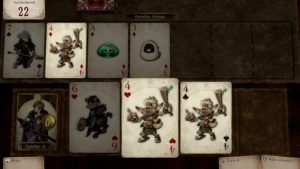
Maasa Mimura: Das war etwas, in das wir viel Energie gesteckt haben. Es freut mich zu sehen, dass Spieler genau das mögen. Vielen Dank.
Ich habe nie darüber nachgedacht, es im Haupt-Kampfsystem zu verwenden. Es würde sich sicherlich sehr anders anfühlen, wenn wir das getan hätten!
Das Development-Team hat jedoch sehr viel darüber diskutiert, wie es sich anfühlen würde, wenn wir es als eigenständiges Spiel herausbringen würden. Bevor das aktuelle Minispiel geboren wurde, haben wir analoge Versionen mit Ideen zusammengestellt. Dies waren kompliziertere Ideen wie: Mehrere Spieler müssen zusammen arbeiten, um Drachen zu besiegen oder Territorien zu verteidigen/einnehmen.
Es wäre sicher toll, wenn diese Ideen irgendwann in Form von digitalen Spielen Realität werden.
Crystal Universe: In den meisten Spielvideos wird klar, wenn der Spieler ein digitales Table-Top wie Monopoly oder in einer Art lebenden Welt spielt.
Das ist in VoC jedoch nicht einfach festzustellen. Die Terrain-Karten werden auf einem virtuellen Tisch abgelegt und jeder Charaktertext, wie auch die Story werden von einem Erzähler gesprochen.
Wir haben so viele Fragen dazu: Wissen die Ingame-Charaktere Bescheid über ihre Existenz? War die Intention, dass es digital auf Spieler wirkt, von Anfang an gegeben? Können Sie uns erleuchten?
Yoko Taro: Die Frage, ob die Charaktere im Spiel tatsächlich existieren, ist eine interessante Frage. Wenn ich das beantworten müsste, klinge ich sicher wie ein alter Lehrer: „Sie existieren in den Herzen und Köpfen der Spieler – mehr als im Spiel selbst.“
Wenn ich jedoch flax antworten sollte: „Sie existieren nicht – das Gleiche gilt aber auch für uns und unsere Welt.“ Wählt also was immer ihr möchtet.
Crystal Universe: Das Gameplay und die Umgebungsdesigns sehen um Einiges einfacher aus als bei Titel wie Drakengard oder NieR. Die Charakterdesigns sind jedoch umwerfend. Alle sind so detailreich und haben ihren eigenen Charme. Welche Charakterdesigns mögen sie besonders?
Kimihiko Fujisaka: Ich mag alle Charaktere, aber der „Fischer“ ist ein ganz besonderer Favorit. Er ist kein Charakter, den ich normalerweise zeichne – also hat er jede Menge Spaß gemacht. Ich mag auch das „Knäulfell“-Monster, weil es süß ist.
Crystal Universe: Ich mag, dass der glückliche und alberne Ton des Spiels zum Ende hin umschlägt. Vor allem waren die Entscheidungen, die der Spieler treffen muss, sehr brutal. Warum haben Sie kein Happy End gewählt?
Yoko Taro: Ich habe die Geschichte nicht komplett selbst geschrieben und mit einem neu anfangenden Scenario Team zusammengearbeitet. Das Ende basiert auf den Ideen der Teammitglieder – es spiegelt also wieder, wie brutal die Jugend ist.
Crystal Universe: So wie der Spieltitel geschrieben wurde, indiziert VoC eine fortführende Franchise. Wenn es zu einem Sequel oder einem weiteren Teil kommen sollte: Würden Sie einen zweiten Teil der Dust-Story im mittelalterlichen Setting entwerfen oder etwas komplett anderes?
Yoko Taro: Yoko Taro ist ein Sklave des Kapitalismus‘ – gebt ihm einen Auftrag und Geld und er schreibt alles, was ihr wollt.
Yosuke Saito: Es würde in der gleichen Welt stattfinden, aber persönlich würde ich ein anderes Charakter-Set präferieren. Wir haben sicher großartige Gelegenheiten dazu.
Das hängt natürlich in erster Linie davon ab, ob VoC: Dragon Isle sich gut verkauft. Also unterstützt das Spiel!
Crystal Universe: Vielen Dank für Ihre Zeit!
Yoko Taro: Vielen Dank an euch!
First of all, thank you for the opportunity to do this interview. The game is a lot of fun. The structure of the game world, the detailed design as well as the story create a fantastic atmosphere.
Yoko Taro: I am very happy when people call my games “fun” or “excellent”, but the best thing is that you did not praise the music! Composer Mr Keiichi Okabe gets all full of himself if you praise him too much you see, so I don’t want people singing his praises any more than they have already.
Crystal Universe: It currently seems to be a trend in the gaming industry to use playing cards as separate minor gameplay element in bigger video games. Voice of Cards might be the first game ever where every tiny detail is based on cards, including worlds design and storytelling. How did you come up with these creative ideas?

Yoko Taro: All video games are all made up of representations and symbols. Things like player characters, bosses, HP, MP etc. are nothing if not shorthand representations. So I decided to depict all the elements using cards to draw attention to that aspect of symbolic representation in this game.
That’s actually a big lie. The real reason I did it is because it costs money to get 3D models made, so I used nice cheap cards instead…
Crystal Universe: You decided to use different dices and some gems as tokens during fights. These objects fit the games overall table-top feel, but they are breaking the “cards only theme” that is used everywhere else. Why did you decide to go this way?
Maasa Mimura: Showing absolutely everything with cards only would likely make for a bit of a dull presentation, so I was torn about how to approach it. Then I remembered a discussion from the very start of the development when someone said they would like playing the game to feel like a laid back drinks and board game night, and decided on the direction right there. I personally like board games where the components have been well crafted and thought about the designs in terms of things that would be great if they were produced as real analogue items. I particularly like the shiny gems, so I am very happy that you noticed those!
Crystal Universe: I’d think that kind of humour we can expect in a Yoko Taro game is well known by now. But what we really didn’t expect was the possibility to play a card game inside of Voice of Cards as well. I really like the parlours basic idea and the different rule set. Did you ever consider using this system as the main fighting mechanic or is there another reason why it was implemented as a standalone multiplayer mode?

Massa Mimura: This was something we put a lot of effort into, so I am delighted that people liked it. Thank you. I had not thought about using it in the main battle system, and it would certainly make it feel different if we did that! We had not considered using this kind of mechanic in the main part of the game, but the development team did discuss how we felt that it was something that could possibly be released as a standalone game in its own right. Before the current mini game was born, we actually put together analogue versions of some other ideas, such as a more complicated game where multiple people co-operate to take down a dragon and a territory capturing game, and put them to one side, so it would be great to see some of those realised as digital games at some point.
Crystal Universe: In most video games it’s pretty easy to tell if we just play a digital table-top game (e.g. Monopoly) or if we take a part in some sort of living world. But that’s not easy to determine in Voice of Cards. The terrain cards get laid down on a virtual table and every character’s text as well as the overarching story is told through the narrator. There are so many questions. Do the in-game characters know about their existence? Do they live in a 2D world or are we just experiencing their story in this 2D way? Is it supposed to be just a digital single player table-top game for us players in the end? Can you tell us what is going on here?
Yoko Taro: Asking if the characters actually exist inside the game is an interesting question. If I were to answer seriously like a big old teacher’s pet then I would say “They exist in the hearts and minds of the players rather than in the game”. However, if you want more of a flippant answer then “They don’t exist at all, and the same goes for us and or our world too.” Please pick up whichever you’d like.
Crystal Universe: While the gameplay and environmental design is way simpler in comparison to titles like Drakengard or NieR, the character designs look just stunning. All of them are very detailed and have a certain charm to them. Which character designs do you personally like best?
Kimihiko Fujisaka: I have an attachment to all of the characters, but the “Piscator” is a particular favourite. He is not the kind of character that I usually draw, so he was fun to do. I also like the Furball Monster too as it is so cute.
Crystal Universe: I really like how the happy and kind of goofy tone of the game started to shift towards the end. Especially the decision that we had to make at the end felt rather brutal. Why did you not make it a happy ending right away?
Yoko Taro: I did not write the whole story myself in this one, and collaborated with the upcoming young scenario team on it. The ending was based on their ideas, so I think that shows how brutal young people really are.
Crystal Universe: The way that the game’s title is written indicates that Voice of Cards could become an ongoing franchise. If some kind of sequel or another entry was developed, would you prefer to tell part 2 of Dust’s story in this medieval setting or rather do something different?
Yoko Taro: Yoko Taro is a slave to capitalism, so if you send him an order and some money he will write anything you like.
Yosuke Saito: It would be set in the same world, but personally I feel that I want to see a different set of characters, and we have a great opportunity to do that.
This all depends on VoC: The Isle Dragon Roars selling well though of course, so please support the game!
Crystal Universe: Finally, we would like to thank you again very much for this interview!
Yoko Taro: Thanks to you too!
Voice of Cards: The Isle Dragon Roars, steht seitdem 28. Oktober 2021 für PlayStation 4, Steam und Nintendo Switch zur Verfügung.

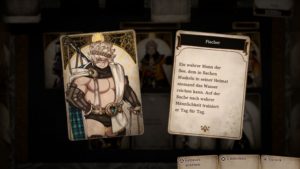

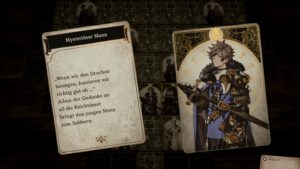


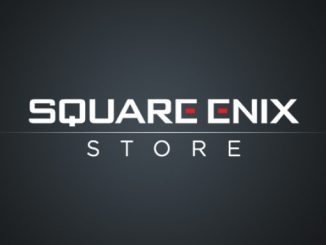
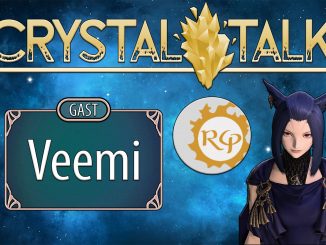
Hinterlasse jetzt einen Kommentar